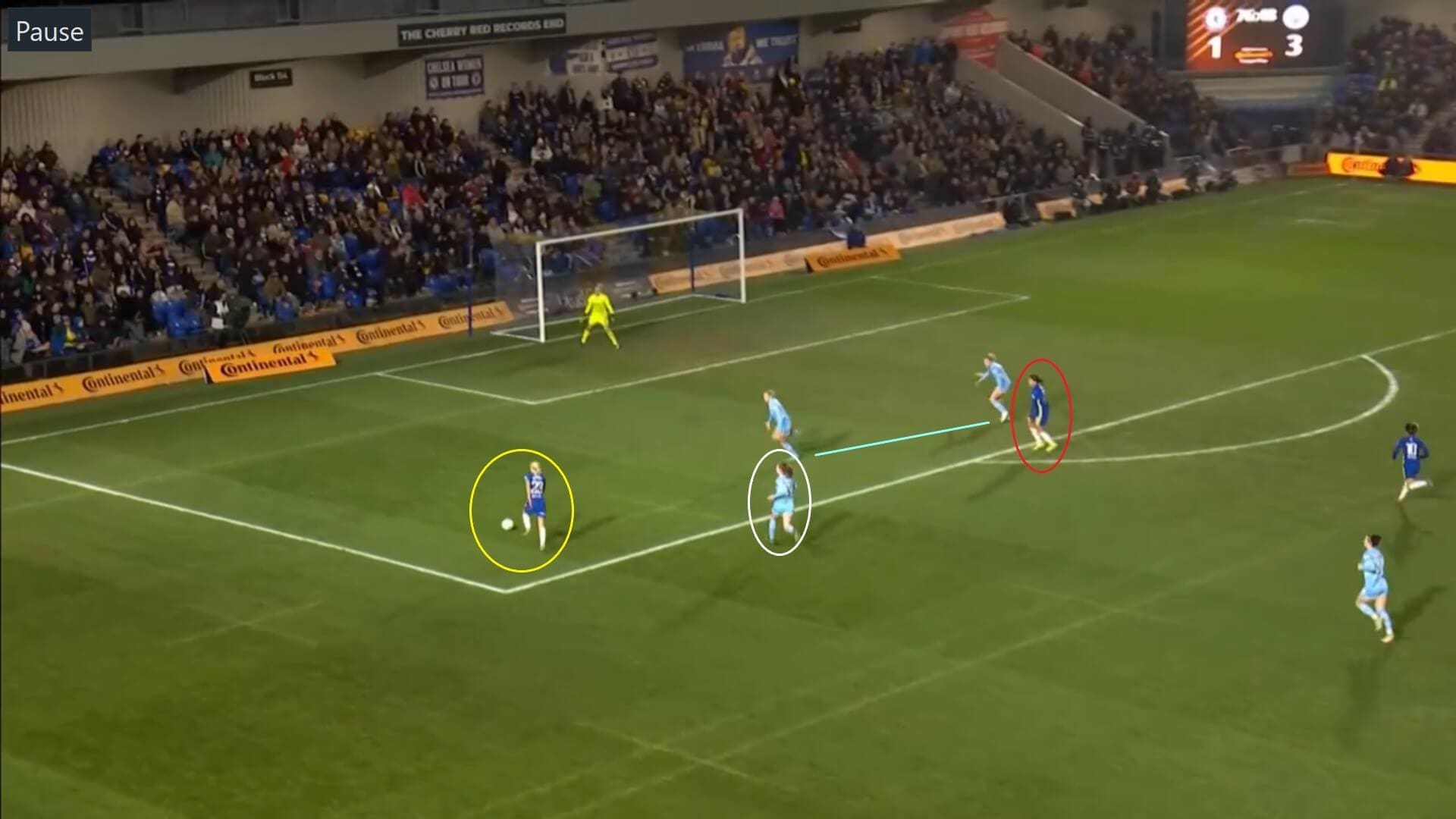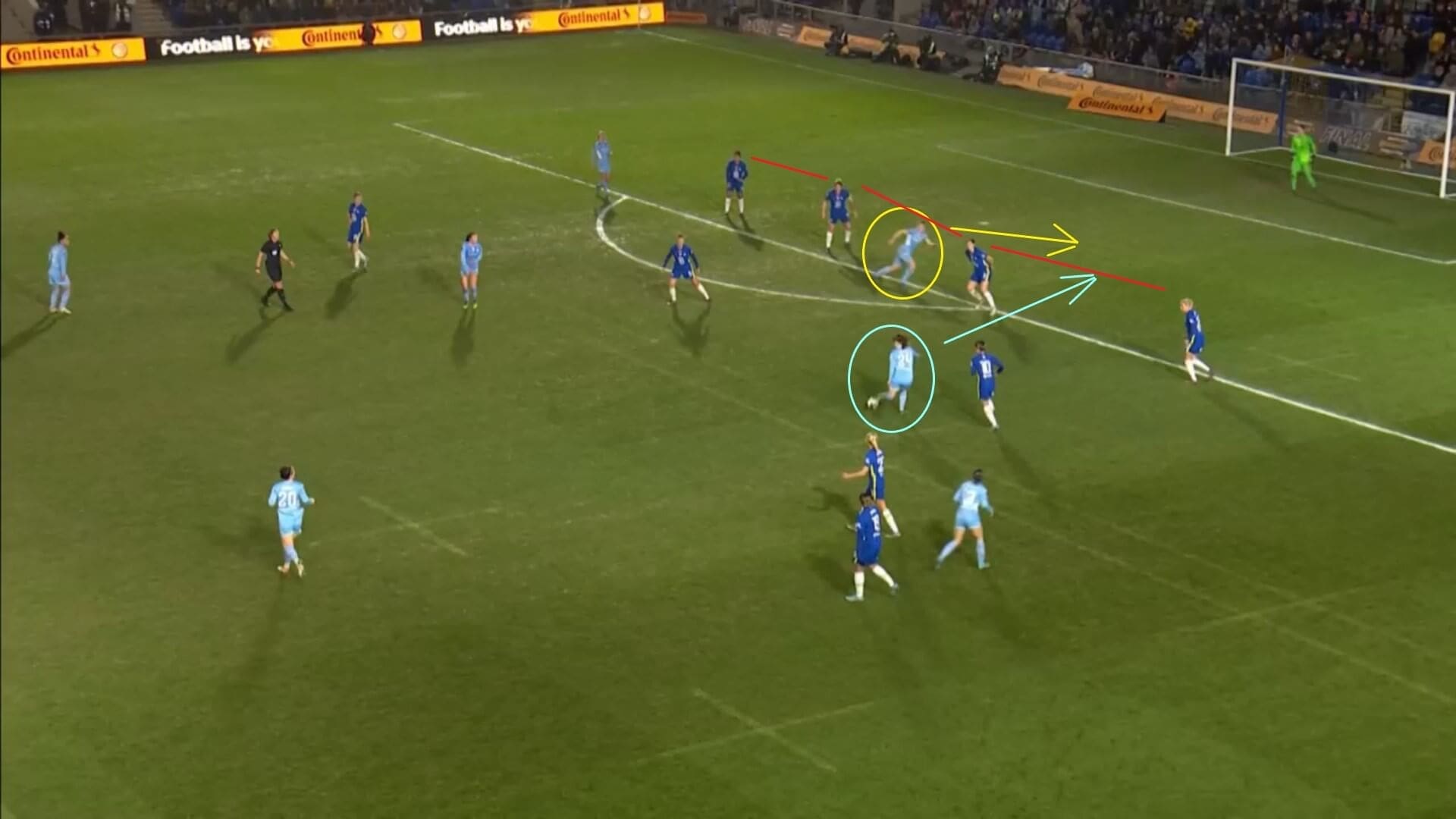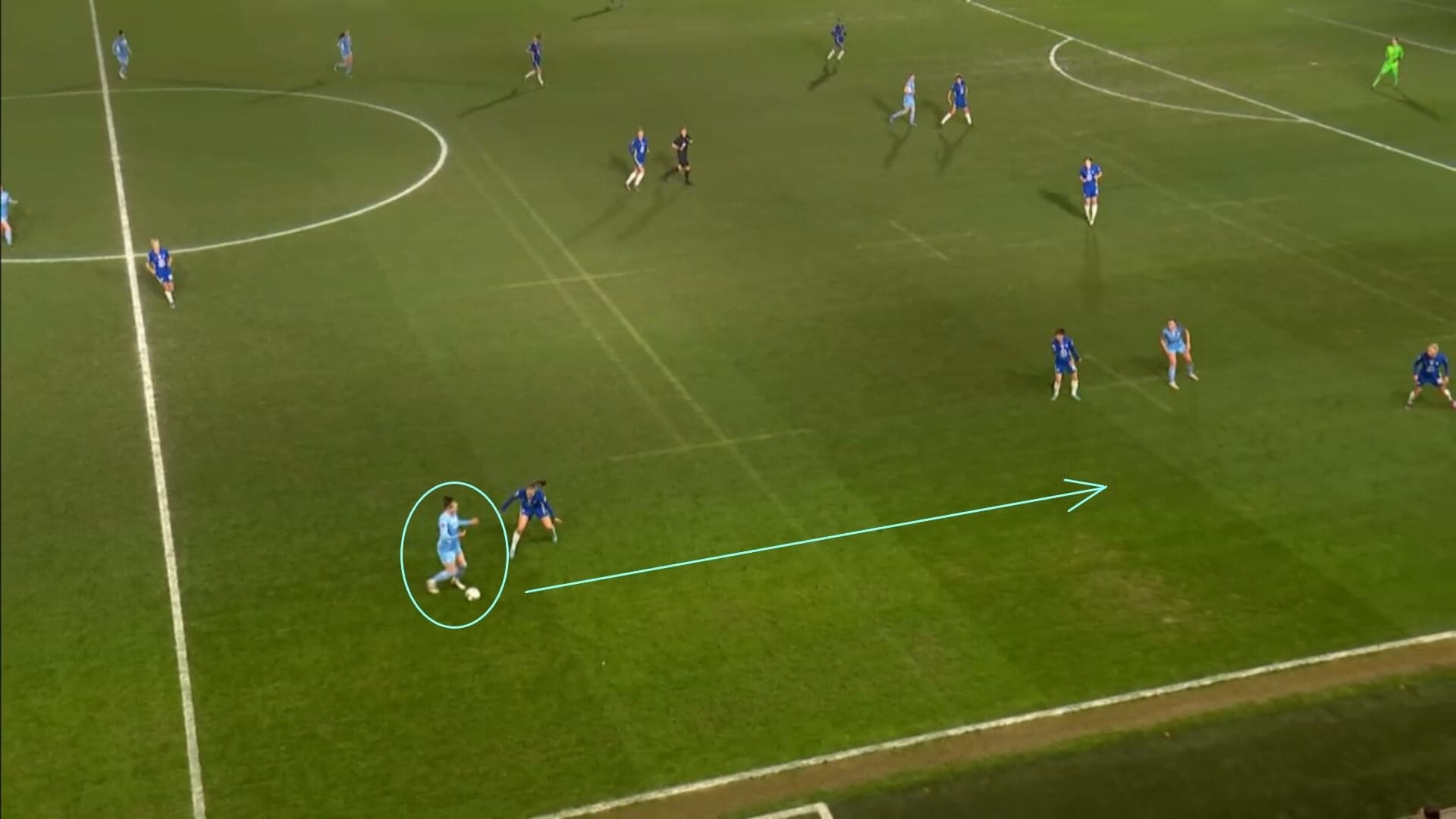It is fair to say that Chelsea Women and Man City Women have had different fortunes in 2021/22 so far. Whilst Chelsea have been competing with Arsenal Women for the WSL title, Manchester City’s initial injury crisis and lack of pre-season meant that they struggled at the foot of the table in the early stages of the campaign. However, their revival over the last few months made this year’s Continental Cup final, held at AFC Wimbledon’s Plough Lane, a difficult one to call.
This tactical analysis will look at both sides’ performances in more detail, focusing on Chelsea’s initial pressure and how they forced errors from their opponents, as well as the problems they encountered during the second half. The analysis will also look at Manchester City’s forward line, highlighting how their improvement during the game was important in halting Chelsea’s run of success in this competition.
Lineups

Chelsea Women made two changes from the team that defeated Leicester City Women in the FA Cup last weekend, with Fran Kirby unwell and former Manchester United Women forward Lauren James moving to the bench. Denmark star Pernille Harder switched to the forward line to partner Sam Kerr, whilst Niamh Charles moved to the wing from right-back. Jess Carter came off the bench to take her place, whilst Norway forward Guro Reiten was also in the starting XI. Club captain Magdalena Eriksson was named on the bench, alongside Maren Mjelde, who has been out with a knee injury for just under a year. Erin Cuthbert and Melanie Leupolz were not involved, with the latter now out of action after this week announcing her pregnancy.
Manchester City Women made two changes from their own FA Cup derby victory at Manchester United, with former Barcelona Femení captain Vicky Losada picking up a knock in that game and not being risked, whilst English winger Jess Park was named on the bench. Into the team came Scotland’s Caroline Weir and former Everton Women winger Hayley Raso, who started in midfield and attack respectively. Steph Houghton is likely to miss the rest of the campaign after undergoing surgery on an Achilles injury, so Ellen White had the armband, whilst experienced midfielder Laura Coombs was passed fit and included among the substitutes.
Chelsea Women’s pressure
It was evident that Chelsea Women were not at their best in the first half of this game, and really missed the influence that Fran Kirby and Canada’s Jessie Fleming bring to the team. However, with both ruled out of this game, Emma Hayes needed to find a different way of posing a threat and limiting Manchester City Women’s options in possession.

What she opted for was to bring the two wingers, Niamh Charles and Guro Reiten, into more central positions, with both effectively operating inside the half-spaces during the first half. Normally, Chelsea’s two wide forwards would play in this area, with Pernille Harder looking especially dangerous in this role throughout the campaign. However, because they had a front two and no wing-backs here, this was Hayes’ way of continuing to use those channels in this new system.
Tactically, this allowed both Charles and Reiten to support Sam Kerr and Harder when the team had the ball, and to sit back and prevent Manchester City’s midfield trio from dominating the central third when without it. Charles in particular found plenty of open spaces around Manchester City’s goal area during the first half and was one of Chelsea’s most dangerous players, whilst Kerr and Harder were able to work closely together and press whichever opponent had the ball.

This pressing from the front was what led to Manchester City’s errors, as they weren’t being given time to think about where to move the ball to. When they did have time, they found that their passing options were limited, as Kerr and Harder were both taking up good positions and making it difficult for the defenders to pass out from the back.
In effect, Chelsea were in control without having large amounts of possession, which was something that Hayes picked up on in her post-match comments. She will have no doubt been pleased with how her team continued to force mistakes and interceptions before half-time, and the fact that Manchester City were unconvincing throughout the first 45 minutes came down mostly to Chelsea’s tactics, so this is something that we need to give them credit for.

Another thing that Hayes will have been pleased with is the speed of Chelsea’s transitional play, allowing them to exploit open spaces before their opponents could get back to close them off. Here, Chelsea have won the ball from a Manchester City corner and instantly taken it up the pitch, with Charles moving it to Reiten ahead of her. The Norwegian now has space in front of her and a good passing option in Harder, who has a clear route to goal. This move shows how dangerous Chelsea are when every player works together and demonstrates why they have been such formidable opponents over the years.
Whilst their build-up play was excellent, their finishing was generally left wanting, and this is where they would have been a little frustrated. Hayes felt that her side did enough in the first half without looking too convincing, which is a fair assessment to make, but what was clear was that Chelsea had a game plan which succeeded in putting Manchester City under continuous pressure with the ball. Therefore, on the balance of things, Chelsea perhaps had the edge at this point in the match.
Chelsea Women’s problems
Not converting their chances did mean that the game was still up for grabs in the second half though, which seemed to spur Manchester City Women on as the game got back underway. Chelsea Women would have normally turned to those players who could add a spark at this point, but their aforementioned absences meant that, in the face of Gareth Taylor’s side’s resurgence, they became disjointed and struggled to contain their opponents.

Emma Hayes said before the game that she had been working on something tactical with Kerr during the week, and the Australian’s constant movement around the pitch seemed to indicate that Chelsea didn’t want to give Manchester City any opportunity to isolate her, which might have happened if she had remained around the box.
This freedom was also why Kerr was able to press the Manchester City players so well in the first half. However, with Manchester City getting more players back to help the defence after the break, pressing individual players no longer became an option. As this situation shows, Manchester City could now use their numerical superiority to surround Kerr and cut her off, limiting her influence on the game, and Chelsea struggled to create many clear-cut chances in the second half as a result.

This inability to be as creative in the final third meant that they lost their confidence and began to show hesitation when in possession. Here, Harder and Kerr are looking to create a goalscoring opportunity, but Kerr has momentarily halted her run and remained in front of the two Manchester City defenders. This forced Harder to pass backwards and not into the open space behind the defenders, with Keira Walsh easily winning the ball and ending the threat.
Again, this was an improvement that came from the increased numbers at the back for Taylor’s side, and it was something that Chelsea couldn’t adapt to. They are normally a well-oiled machine, but this was not the only time that they looked unsure of what to do with the ball, and it was clear that their first half tactics did not have the same impact once their opponents had the upper hand.

It wasn’t only in attack where Chelsea had a poor second half, as Manchester City also found it easier to play through their defensive line and create their own chances. Georgia Stanway had been getting into some dangerous areas during the first half, but Manchester City encouraged their midfielders to get further forward in the second and increase the pressure on their opponents.
In this case, Walsh passes the ball through to Ellen White, who meets it in the space behind, but the concerning thing here is that Chelsea’s defence didn’t make any attempt to stop the pass going through. Hayes said after the game that her team had conceded some uncharacteristically poor goals, and this would have been another to add to that list if White had not fired directly at goalkeeper Ann-Katrin Berger.
The thing is that we have seen this lapse in defensive concentration from Chelsea before, with Barcelona also finding spaces behind their defence during last season’s Champions League final. Therefore, this is something that they need to work on, as it has now cost them in two of their last three finals and shows that there is a weakness there for opponents in any game to exploit.
Manchester City Women’s forward line
We have so far analysed Chelsea Women’s performance in this final, but this article will now switch focus to Manchester City Women’s forward line, and how their improved second half showing was key to Gareth Taylor’s side turning the game in their favour and creating more problems for Chelsea.

When the lineups were first announced, we expected that Manchester City would play in an attacking manner, with all three of Raso, White and Hemp tending to get behind opponents at every opportunity. However, whilst this was clearly the intention, the forwards didn’t seem to click and always looked slightly out of sync with each other in the first half. In this case, White is looking to break through the line, but neither Raso nor Hemp are in a position to support her, making it easy for Chelsea to surround the England striker and end the threat.
When Manchester City did get more players behind the defence and show more unison, it was harder for Chelsea to defend against them, with Hemp having the best chance of the half when she turned a cross from the impressive Stanway onto the post.

In the second half, Manchester City displayed more quality with the ball, and the full-backs played an important part in their newfound confidence. Lucy Bronze had been quiet in the first half by her standards, not really troubling Chelsea and failing to offer her usual attacking threat.
However, she and left-back Demi Stokes both advanced up the field more in the second half and looked to control the channels, supporting the attackers and giving Manchester City more numbers in the final third when they had possession. In this situation, Bronze dribbled the ball forwards herself, whereas she might have looked to pass it and hold her position in the first half. This ensured that there was less chance of Chelsea intercepting the ball, and so getting the full-backs higher up the pitch was another key tweak in Manchester City’s tactics.

The knock-on effect of this was that the forward line didn’t have to cover the wings as much as they did in the first half, meaning that we began to see them work more closely together, giving Manchester City a bigger presence in the final third. Raso played in the half-spaces, where we know she can have an impact on her team’s play, whilst Hemp drove inside and constantly beat individual Chelsea defenders, setting up numerous chances for her teammates.
White, meanwhile, continued to move between the defenders, but she now had the support from the other two to ensure that these runs were turned into shots on goal. If we add Caroline Weir and Stanway to the equation, with both operating in higher areas of the pitch during the second half, then we can see why Manchester City posed a greater attacking threat and ultimately won the game.
Conclusion
In conclusion, this tactical analysis has shown how this year’s Continental Cup final really was a game of two halves. Both sides were average before halftime, but it was Manchester City Women who took control afterwards. Emma Hayes said that the absence of Chelsea Women’s key players was the likely reason for their defeat, and it is possible that having one or both of Kirby and Fleming in the team could have made a difference on the day.
Gareth Taylor, on the other hand, was delighted by the way his side stepped up after the break, describing his players as “magnificent” and their second-half performance as “immense” in his post-match comments. After questions over his future at the beginning of the season, this victory will go a long way in restoring the fans’ faith in his leadership.
Chelsea’s next game sees them face a tricky league trip to mid-table West Ham United Women on Thursday night, as they look to make up some of the points between them and Arsenal. Manchester City, meanwhile, are next in league action on Sunday, when they travel to fellow top-four rivals Tottenham Hotspur Women.





Comments